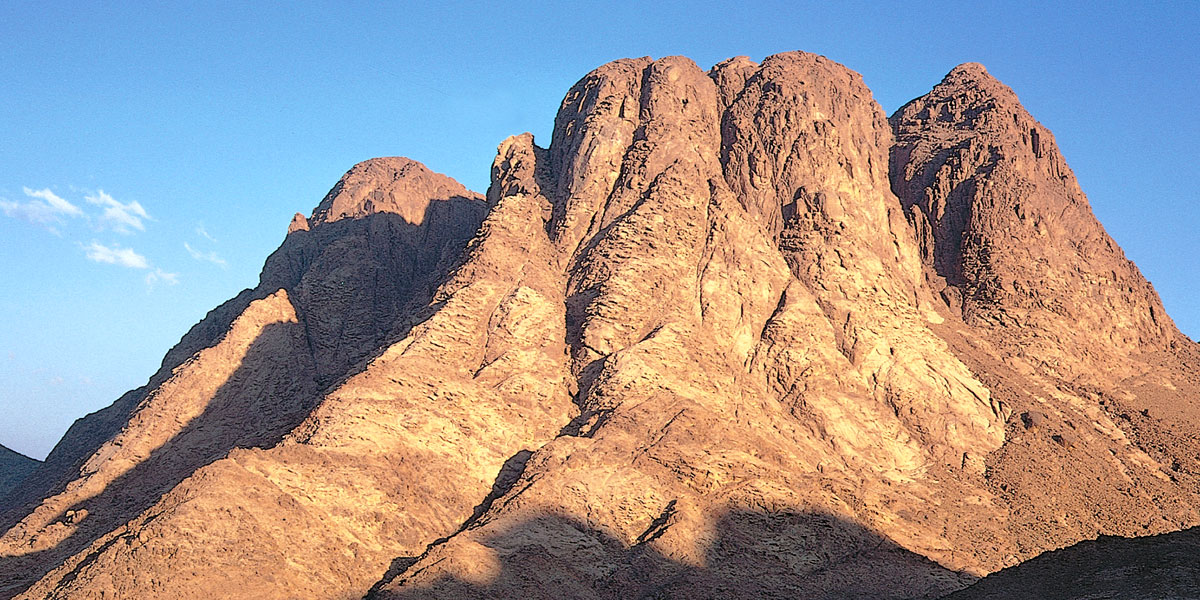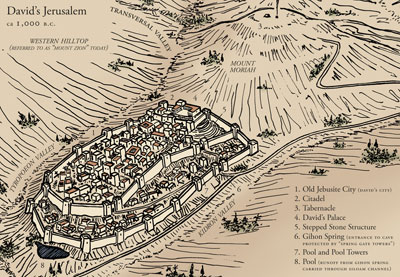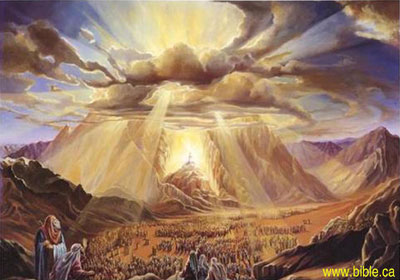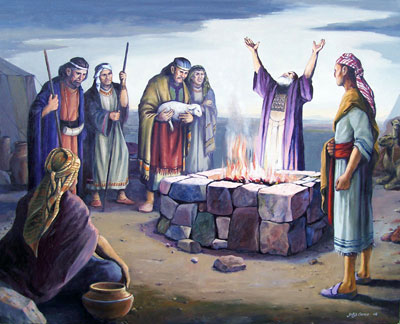
The Know
There are two major covenants in the Bible, each associated with a holy mountain, that shape much of Old Testament history, narrative, and prophecy: (1) the covenant associated with Mount Sinai, where Moses met God and received the Law; (2) the covenant given to the Davidic monarchy, which is associated with Mount Zion in Jerusalem, where the Temple of Solomon was located. The sets of beliefs and understanding that formed around each of these covenants are known as “Sinai theology” and “Zion theology” respectively. As LDS Bible scholar Taylor Halverson has argued, understanding these two main biblical covenants can help us understand the Book of Mormon.1
Zion Theology: “All Is Well in Zion”
Zion theology is built around the idea that God covenanted with King David and his descendants that their royal line would last forever (see 2 Samuel 7:8–16).2 This promise was seen as an unconditional covenant; in other words, it was given without any requirements, obligations, or prerequisites. The Lord declared of David: “If he commit iniquity, I will chasten him with the rod of men … But my mercy shall not depart away from him, … and thy kingdom shall be established for ever” (2 Samuel 7:14–15). In Zion theology, it was also believed:
1. That God has chosen Zion (referring to Jerusalem) as his earthly abode. The Temple of Solomon, and particularly the Ark of the Covenant within the temple, represented God’s presence in Jerusalem.
2. That God is an undefeatable Divine Warrior who protects Zion. As long as God is in His temple in Jerusalem, the city cannot be conquered. God has conquered Israel’s enemies in the past, and will continue to do so.3
Psalm 48 is a good demonstration of the perspective of Zion theology.
Great is the Lord, and greatly to be praised in the city of our God, in the mountain of his holiness [Mount Zion]. … God is known in her palaces for a refuge. … As we have heard, so have we seen in the city of the Lord of hosts, in the city of our God: God will establish it for ever. (Psalm 48:1, 3, 8)
Some people may have used Zion theology as an excuse for not repenting, thinking “Jerusalem can never be destroyed” or “all is well in Zion.” In Jeremiah 22–28, the people of Jerusalem did not believe that they needed to make any deals with the King of Babylon because God would protect them. Jeremiah prophesied that the Lord would only protect the Davidic monarchy and Jerusalem when they were righteous, and that Jerusalem would soon be destroyed by the Babylonians. Jeremiah was thrown into prison and almost put to death for this prophecy.
Sinai Theology: “If ye keep my commandments ye shall prosper in the land”
In contrast to Zion theology, the Sinai covenant was conditional, in that the blessings promised were dependent upon the people’s obedience to the stipulations given by God. These requirements are known as the Law of Moses, which includes the Ten Commandments (see Exodus 19–24; Deuteronomy 11). If the people fell into iniquity and broke the laws of God, they would be cursed instead of blessed. In Sinai theology, it was further believed:
1. Moses was an ideal human figure. Beginning with Moses’ successor, Joshua, subsequent prophets were compared to or depicted as similar to Moses.
2. Sinai theology was associated with the northern kingdom of Israel, whereas Zion theology belonged to the southern kingdom of Judah (where Jerusalem was located).
3. The Sinai covenant was typical of Ancient Near Eastern suzerain-vassal treaties, which were covenants between a ruler and less-powerful party, or “vassal,” that were conditioned upon the vassal’s submission to the suzerain.4
4. God is the king; any human king is to be the chief scriptorian, subject to God (see Deuteronomy 17:14–20).
5. Sinai theology is associated with the scribal class.
A frequent promise found in the book of Deuteronomy summarizes the perspective of Sinai theology: “Walk in obedience to all that the Lord your God has commanded you, so that you may live and prosper and prolong your days in the land that you will possess” (Deuteronomy 5:33, NIV).5
Sinai and Zion Theology in the Book of Mormon
The Book of Mormon appears to support Sinai theology rather than Zion theology. The name David is mentioned 1,127 times in the King James Version of the Bible, but it shows up only seven times in the Book of Mormon.6 The only direct mentions of King David come in the words of Jacob, and they are all negative references to David’s iniquities (Jacob 1:15; 2:23, 24). The Nephites, apparently, did not look upon David and his dynasty with high regard. Moses, in contrast, is mentioned 65 times in the Book of Mormon.
Nephi quoted from Isaiah extensively, but avoided the parts with Zion theology. Similarly, Book of Mormon authors tended to avoid Psalms which were clearly related to Zion theology (like Psalm 48).7 Nephi drew more from Exodus and Deuteronomy, the story of Moses.8 As Dr. Halverson has said, “Nephi wanted to be a prophet like Moses, not a king like David.”
The Why
It is apparent that, as Dr. Halverson has argued, we must understand the covenant at Sinai if we wish to understand the Book of Mormon. Lehi, Nephi, and their descendants in the promised land clearly cherished and adhered to the covenant at Sinai, and greatly emphasized Sinai theology over Zion theology. But why was this the case?
As noted above, Sinai theology was associated with the northern kingdom of Israel. Alma 10:3 informs us that Lehi was a descendant of Manasseh, a tribe of the northern kingdom. Although Lehi’s family moved to Jerusalem at some point, they were not natives of the southern kingdom. It appears that Laman and Lemuel had bought into the views of the local Zion theology, in that they did not believe that the great city of Jerusalem could be destroyed. They despised the fact that their father, much like Jeremiah and other prophets, was preaching that it would be (1 Nephi 2:12–13).
Lehi was likely close to Jeremiah, and his visions have a similar thrust to what Jeremiah was prophesying at the time.9 Furthermore, Nephi was likely trained as a scribe, and, thus, would have been influenced by the scribal class’s interest in the Sinai tradition. Although we do not know all of what was on the plates of brass, we do know that it contained the five books of Moses, and also many of the words of Jeremiah (1 Nephi 5:11, 13). The plates of brass may have been a record that came from the northern tribes of Israel, so they may have been less influenced by Zion theology.
Furthermore, Lehi and Nephi seemed to have seen the great potential that Sinai theology had for application to their own situation. In their journey through the wilderness, Lehi knew that his family would need to be faithful to the Lord in order to be blessed. Lehi and Nephi would need to be like Moses in order to lead their family according to God’s will. As Neal Rappleye has argued, “Lehi draws on the figure of Moses because he knows it will appeal to Laman and Lemuel, but at the same time he is using the Moses type to suggest that he himself was a true and legitimate prophet.”10
Although the Lord did, indeed, make important promises to King David, and to his royal line after him, which would eventually be fulfilled in the person of Jesus Christ, the meaning of this covenant for the people of God was often misinterpreted. Lehi and Nephi knew, and wanted to teach their descendants, and future readers of the Book of Mormon, that it is only when we keep the commandments of God that He will help us “prosper in the land” (1 Nephi 4:14).
“We must understand the covenant at Sinai, if we wish to understand the Book of Mormon.”11
Further Reading
Taylor Halverson, “Covenant Patterns in the Old Testament and the Book of Mormon,” presentation given at the 2017 BMAF–BMC Book of Mormon Conference, accessed online at https://youtu.be/UCUdceAvM0A.
Neal Rappleye, “The Deuteronomist Reforms and Lehi’s Family Dynamics: A Social Context for the Rebellions of Laman and Lemuel,” Interpreter: A Journal of Mormon Scripture 16 (2015): 87–99.
Noel B. Reynolds, “The Israelite Background of Moses Typology in the Book of Mormon,” BYU Studies 44, no. 2 (2005): 5–23.
Noel B. Reynolds, “Lehi as Moses,” Journal of Book of Mormon Studies 9, no. 2 (2000): 26–35.
S. Kent Brown, “The Exodus Pattern in the Book of Mormon,” in From Jerusalem to Zarahemla: Literary and Historical Studies of the Book of Mormon (Provo, UT: Religious Studies Center, Brigham Young University, 1998), 75–98.
Addendum
|
Sinai Theology |
Nephi |
Zion Theology |
|---|---|---|
|
Moses |
Nephi wants to be a prophet like Moses, not a king like David |
David |
|
Northern Kingdom of Israel |
Nephi’s ancestry is from the Northern Kingdom |
Southern Kingdom of Judah/Jerusalem |
|
Conditional covenants |
Conditional covenants |
Unconditional covenants |
|
God is the King: Any human king is to be chief scriptorian |
Nephi rejects kingship because God is the King; Nephi becomes chief scriptorian |
Davidic dynasty is eternal |
|
Scribal class |
Nephi from scribal class |
Jerusalem Temple & royal court class |
|
Wisdom tradition |
Nephi is a wise man |
- 1. The ideas expressed in this KnoWhy are largely drawn from an conference presentation given by Taylor Halverson. See Taylor Halverson, “Covenant Patterns in the Old Testament and the Book of Mormon,” presentation given at the 2017 BMAF–BMC Book of Mormon Conference.
- 2. In the Old Testament, the name Zion was often used to refer to the city of Jerusalem (2 Samuel 5:7), which was considered to be the city of God (Psalm 87:2–3). The name Zion can be applied to other cities and groups of people, as is seen in both ancient and modern scripture (Zechariah 9:13; Hebrews 12:22; Doctrine and Covenants 45:66–67; 57:2–3; 97:21; Moses 7:18–19). The use of the term “Zion” in this publication should be understood as referring to the Jerusalem of ancient times and not to the idea of the city of Zion, or New Jerusalem, nor to the doctrines or theology involved with it, as revealed to the Prophet Joseph Smith.
- 3. See Book of Mormon Central, “Why Does Jacob Describe God as a Divine Warrior? (2 Nephi 6:17),” KnoWhy 227 (February 20, 2017).
- 4. “The assumption is that Israel conceived of its relation to Yahweh as that of subject peoples to a world king and that they expressed this relationship in the concepts and formulas of the suzerainty treaty.” Norman K. Gottwald, The Hebrew Bible: A Socio-Literary Introduction (Minneapolis, MN: Fortress Press, 1985), 205.
- 5. See also Exodus 20:12; Deuteronomy 4:1, 40; 5:29; 6:1, 3; 11:9.
- 6. Three are from Nephi’s quotations of Isaiah (2 Nephi 17:2, 13; 19:7), and one is the name of a location (Mormon 2:5).
- 7. Some Psalms related to Zion theology include Psalms 46–48, 76, 84, 93, 96–99, 132, and others. For more on the Psalms in the Book of Mormon, see Book of Mormon Central, “Why Does Jacob Quote So Much from the Psalms? (Jacob 1:7; cf. Psalm 95:8),” KnoWhy 62 (March 25, 2016); Book of Mormon Central, “Why Does Nephi Quote a Temple Psalm While Commenting on Isaiah? (2 Nephi 25:16),” KnoWhy 51 (March 10, 2016); Book of Mormon Central, “Why Did Ammon Borrow So Much from Tradition in Alma 26? (Alma 26:8),” KnoWhy 133 (June 30, 2016); Book of Mormon Central, “Why Did Lehi Quote from a Psalm of Repentance in His Dream? (1 Nephi 8:8),” KnoWhy 325 (June 12, 2017); John Hilton III, “Old Testament Psalms in the Book of Mormon,” in Ascending the Mountain of the Lord: Temple, Praise, and Worship in the Old Testament (2013 Sperry Symposium), ed. Jeffrey R. Chadwick, Matthew J. Grey, and David Rolph Seely (Salt Lake City and Provo, UT: Deseret Book and Religious Studies Center, Brigham Young University, 2013), 291–311.
- 8. See, for example, Noel B. Reynolds, “The Israelite Background of Moses Typology in the Book of Mormon,” BYU Studies 44, no. 2 (2005); Neal Rappleye, “The Deuteronomist Reforms and Lehi’s Family Dynamics: A Social Context for the Rebellions of Laman and Lemuel,” Interpreter: A Journal of Mormon Scripture 16 (2015): 87–99; Noel B. Reynolds, “Lehi as Moses,” Journal of Book of Mormon Studies 9, no. 2 (2000): 26–35. S. Kent Brown, “The Exodus Pattern in the Book of Mormon,” in From Jerusalem to Zarahemla: Literary and Historical Studies of the Book of Mormon (Provo, UT: Religious Studies Center, Brigham Young University, 1998), 75–98; Book of Mormon Central, “Why is Lehi Depicted as Similar to Moses? (2 Nephi 3:9–10),” KnoWhy 268 (January 30, 2017).
- 9. See David Rolph Seely and Jo Ann H. Seely, “Lehi and Jeremiah: Prophets, Priests, and Patriarchs,” Journal of Book of Mormon Studies 8, no. 2 (1999): 24–35, 85–86.
- 10. Neal Rappleye, “The Deuteronomist Reforms and Lehi’s Family Dynamics: A Social Context for the Rebellions of Laman and Lemuel,” Interpreter: A Journal of Mormon Scripture 16 (2015): 87–99.
- 11. Taylor Halverson, “Covenant Patterns in the Old Testament and the Book of Mormon,” presentation given at the 2017 BMAF–BMC Book of Mormon Conference.
Continue reading at the original source →






